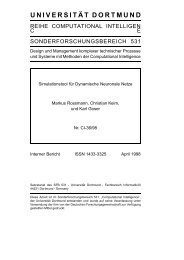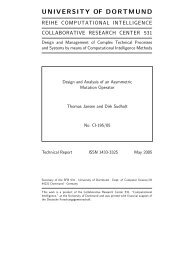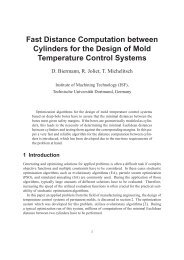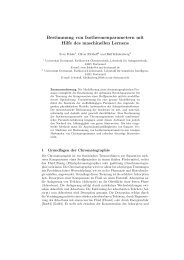Self-Adaptive Genetic Algorithms with Simulated Binary Crossover
Self-Adaptive Genetic Algorithms with Simulated Binary Crossover
Self-Adaptive Genetic Algorithms with Simulated Binary Crossover
You also want an ePaper? Increase the reach of your titles
YUMPU automatically turns print PDFs into web optimized ePapers that Google loves.
Step 1: Choose a random numberu2[0;1).<br />
Step 2: Calculatequsing equation 4.<br />
x(1;t) <strong>with</strong>inq2[(0:01)1 1+;1=(0:01)1<br />
i=2:0andx(2;t) x(2;t+1) i?x(1;t+1) i =qx(2;t) i?x(1;t) i:<br />
Step 3: Compute children solutions using equations 5 and 6.<br />
Note that two children solutions are symmetric about the parent solutions. This is deliberately used to<br />
avoid any bias towards any particular parent solution in a single crossover operation. Another interesting<br />
aspect of this crossover operator is that for a fixed the children solutions has a spread which is proportional<br />
to that of the parent solutions. With simple algebraic manipulations, it can be shown that 99% of<br />
crossovers lie 1+]. For=2, this range isq2[0:215;4:64]. However,<br />
for a fixedq, the difference in children solutions is proportional to that of parent solutions:<br />
(7)<br />
This has an important implication. Let us consider two scenarios: (i) Two parents are far away from each<br />
other, and (ii) two parents are closer to each other. For illustration, both these cases (<strong>with</strong> parent solutions i=5:0in the first case and <strong>with</strong> parent solutionsx(1;t) i=2:0andx(2;t) i=2:5in<br />
the second case) and the corresponding probability distributions <strong>with</strong>=2are shown in Figures 2 and 3,<br />
respectively. For an identical random number,q, as calculated by using equation 4, are the same for both<br />
Probability density function per child<br />
3<br />
2.5<br />
2.5<br />
2<br />
2<br />
1.5<br />
1.5<br />
parentx(1;t)<br />
1<br />
1<br />
solutionx(1;t+1)<br />
parentx(1;t) solutionx(1;t+1) i=1:464<br />
0.5<br />
0.5<br />
0<br />
o o<br />
0<br />
o o<br />
-1 0 1 2 3 4 5 6 7 8<br />
-1 0 1 2 3 4 5 6 7 8<br />
x_i<br />
x_i<br />
Figure 2: Probability distribution of children so- Figure 3: Probability distribution of children solutions<br />
<strong>with</strong> distant parents.<br />
lutions <strong>with</strong> closely spaced parents.<br />
cases. From equation 7, it is clear that in the first case the children are likely to be more widely spread than<br />
in the second case. Figures2 and 3 also show the corresponding children solutions (marked <strong>with</strong> a box)<br />
foru=0:8orq=2:51=3. Figures clearly show that if the parent values are far from each other (the first<br />
case), solutions away from parents are possible to be created. Compare the child<br />
<strong>with</strong> i=2:0. But if the parent values are close by (the second case), distant children solutions<br />
are not likely. Compare the child i=1:911<strong>with</strong> i=2:0creating using the<br />
same random number as in the first case. In initial populations, where the solutions are randomly placed<br />
(like the first case), this allows almost any values to be created as a child solution. But when the solutions<br />
tend to converge due to the action of genetic operators (like the second case), distant solutions are not<br />
allowed, thereby focusing the search to a narrow region.<br />
It is interesting to note that both equations 5 and 6 can be written in the form of equation 1 <strong>with</strong><br />
following relationships:=0:5(1q):However, it is important that, unlike in BLX- operator, the<br />
equivalent term in SBX operator is not uniformly distributed (refer to equation 4). The SBX operator<br />
biases solutions near each parent more favorably than solutions away from parents. Essentially, SBX<br />
operator has two properties:<br />
5<br />
Probablity density function per child<br />
3








